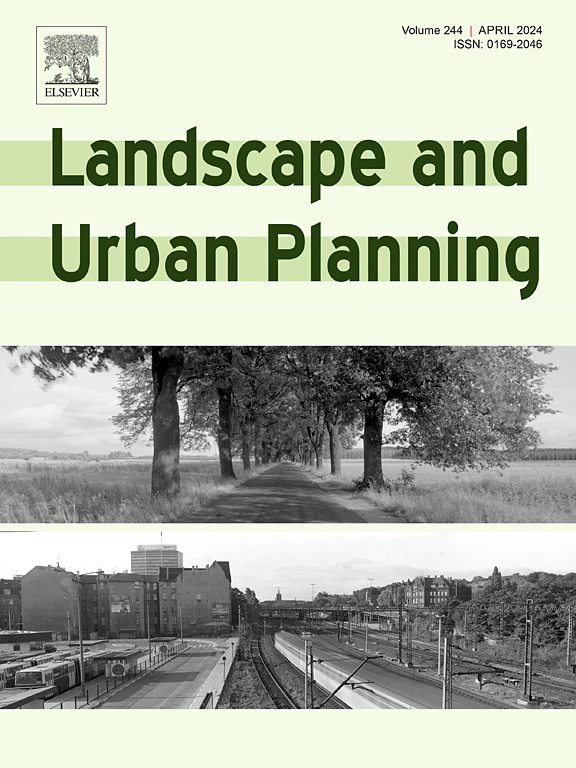The association between suitable compactness of urban expansion and urban green growth
IF 9.2
1区 环境科学与生态学
Q1 ECOLOGY
引用次数: 0
Abstract
Explicit urban growth patterns (UGPs) exhibit complex association with implicit urban green growth (UGG). However, the scaling trajectories linking carbon metabolism and socio-economic development in UGG remain uncertain, and it is unclear which UGP is optimal for local or global UGG. Here, we establish dynamic scaling laws between CO2 emissions and the socio-economic size of 77,677 newly built-up patches over 2012–2020 in China to accurately assess the performance, types, and progress of UGG and further elucidate its suitable UGP and associated factors across scales. Our analysis reveals that UGG performance shows a latitudinal gradient but is significantly poorer in large cities and central China. China’s newly built-up patches display distinct development types, with over three-quarters of them achieving UGG via sub-linear (27.8%) or negative (48.9%) carbon metabolism response patterns to socio-economic growth, whereas the remainder face super-linear carbon pressure (19.5%) or socio-economic decline (3.8%). Notably, compact infill expansion emerges as a locally greener UGP across diverse spatial scenarios, reducing the carbon cost of socio-economic development by 24% and 45% compared to edge and outlying expansion, respectively. Globally, an important exception is a trade-off between overly compact urban expansion and UGG. Moreover, land, economic, technological, and greening factors exhibit spatially non-stationary associations with UGG. Our findings offer insights into dynamic scaling laws in urban microsystems and underscore the critical role of suitable urban compactness and targeted carbon-reduction policies in achieving sustainable urban planning.

城市扩张的适宜紧凑度与城市绿色增长的关系
显性城市增长模式(UGP)与隐性城市绿色增长(UGG)表现出复杂的关联。然而,将UGG的碳代谢和社会经济发展联系起来的缩放轨迹仍然不确定,也不清楚哪种UGP最适合当地或全球UGG。在这里,我们建立了2012-2020年中国77677个新建斑块的二氧化碳排放量与社会经济规模之间的动态标度规律,以准确评估UGG的性能、类型和进展,并进一步阐明其适用的UGP和跨尺度的相关因素。我们的分析表明,UGG性能显示出纬度梯度,但在大城市和中国中部明显较差。中国新建的斑块显示出不同的发展类型,其中超过四分之三的斑块通过对社会经济增长的亚线性(27.8%)或负(48.9%)碳代谢反应模式实现UGG,而其余斑块则面临超线性碳压力(19.5%)或社会经济衰退(3.8%)。值得注意的是,紧凑型填充式扩张在不同的空间场景中成为一种更环保的UGP,与边缘和偏远扩张相比,分别将社会经济发展的碳成本降低了24%和45%。在全球范围内,一个重要的例外是过于紧凑的城市扩张和UGG之间的权衡。此外,土地、经济、技术和绿化因素与UGG在空间上表现出非平稳的关联。我们的研究结果为城市微观系统中的动态缩放规律提供了见解,并强调了适当的城市紧凑性和有针对性的碳减排政策在实现可持续城市规划中的关键作用。
本文章由计算机程序翻译,如有差异,请以英文原文为准。
求助全文
约1分钟内获得全文
求助全文
来源期刊

Landscape and Urban Planning
环境科学-生态学
CiteScore
15.20
自引率
6.60%
发文量
232
审稿时长
6 months
期刊介绍:
Landscape and Urban Planning is an international journal that aims to enhance our understanding of landscapes and promote sustainable solutions for landscape change. The journal focuses on landscapes as complex social-ecological systems that encompass various spatial and temporal dimensions. These landscapes possess aesthetic, natural, and cultural qualities that are valued by individuals in different ways, leading to actions that alter the landscape. With increasing urbanization and the need for ecological and cultural sensitivity at various scales, a multidisciplinary approach is necessary to comprehend and align social and ecological values for landscape sustainability. The journal believes that combining landscape science with planning and design can yield positive outcomes for both people and nature.
 求助内容:
求助内容: 应助结果提醒方式:
应助结果提醒方式:


